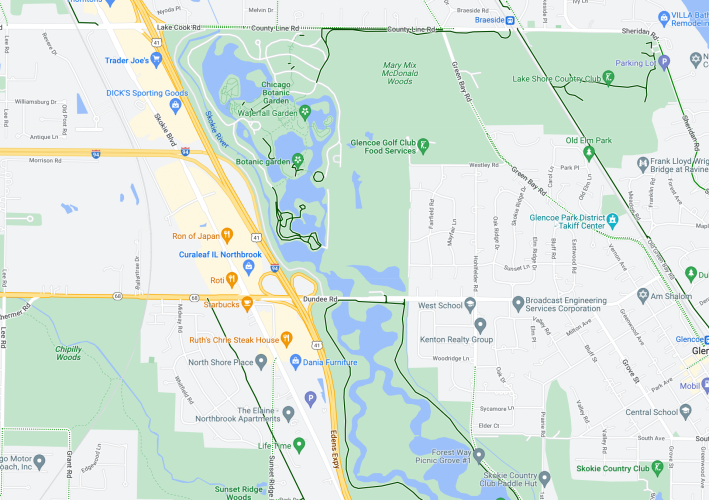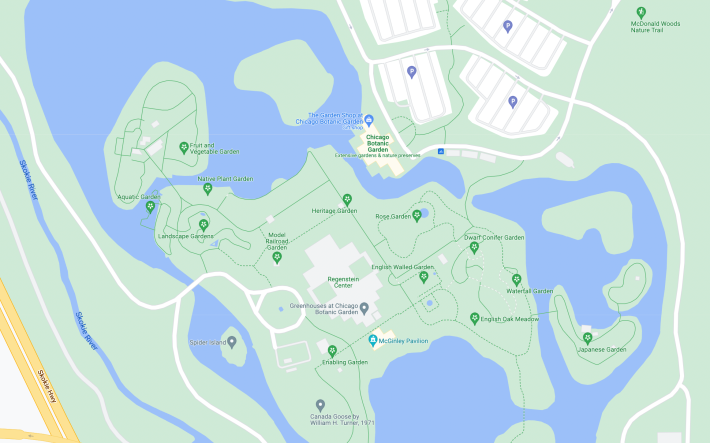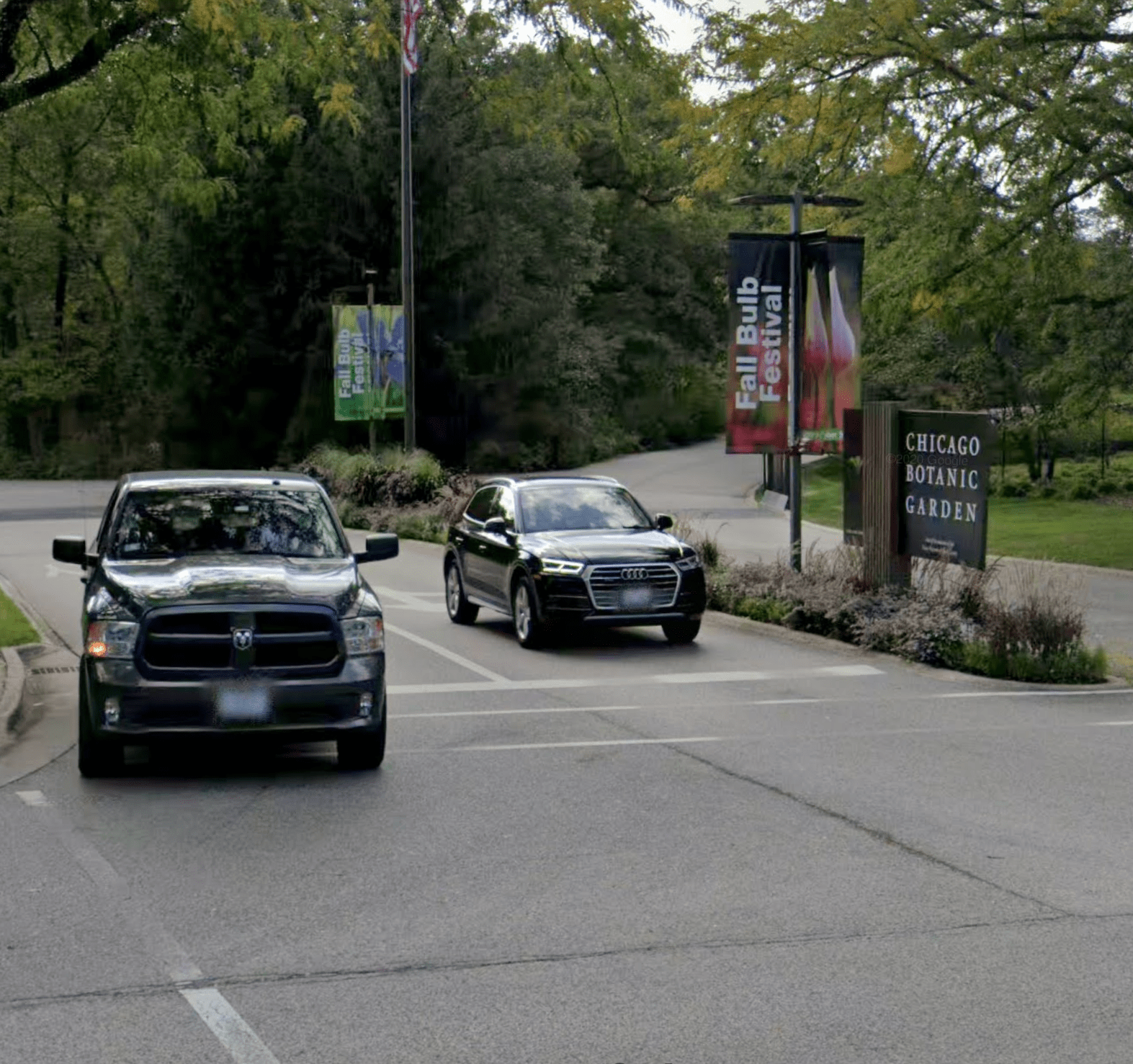The website for the Chicago Botanic Garden, located in north-suburban Glencoe at the north end of the North Branch Trail and about a 20-minute walk from the Braeside station on Metra's Union Pacific North line, has a page dedicated to "Climate Change Initiatives." "Climate change affects everything: our water, our food, the air we breathe," it states. "By teaching the next generations about climate change and harnessing the power of local organizations, we can protect and improve the quality of life for all."
In addition to educating the public about the threat of global warming, one way for the botanic garden to help fight climate change is by making it as easy as possible to walk, bike, or take transit to there instead of driving, reducing emissions. Previously the garden had a policy that did just that. People who walked, biked, or took Metra and/or a Pace bus were able to access all of the usual attractions at the garden for free (although roller-skates and skateboards were banned), with no admission fee.

While there was no admission fee for drivers either, due to parking bans and residential permit parking on streets near the botanic garden, those who drove there were pretty much required to pay the garden's $20-30 parking lot fee. Therefore people who instead used non-car modes that help fight climate change were rewarded by saving a lot of money.
Infuriatingly, the botanic garden recently rolled out a new pricing structure that does the opposite, making it much more expensive to walk, bike, or take transit there. Meanwhile, reduced parking fees mean that under some circumstances it will actually be cheaper to drive there than before. That's completely counterproductive to the garden's stated mission of fighting climate change.

According to a press release from the botanic garden, the new fee system was implemented "to help meet growing public demand and expectations" since the facility has seen a 43 percent increase in attendance in the past decade. "Nature is in demand and the new pricing structure enables the Garden to keep up with increased costs associated with maintaining and sustaining its exceptional gardens, visitor experience, and science and learning programs." The garden also reportedly experienced a $7-10 million revenue shortfall during the pandemic due to closures and limited-capacity days during the worst periods of the COVID-19 pandemic.
As of February, there is a new admission fee that starts at $9.95 per person and goes up as high as $25.95, based on factors like attendance patterns, popular time frames, and weather. That varying, somewhat unpredictable, price structure is euphemistically called "plan-ahead pricing," since you may be able to lock in a lower admission cost if you buy tickets far in advance of your visit.
A WTTW report on the new pricing scheme noted that you're still allowed to enter the botanic garden grounds for free via the North Branch Trail. Erin Benassi, directorof social media and public relations for the garden, clarified to Streetsblog that people on foot and bike are, in fact, allowed to travel around the perimeter of the property for no charge, gazing at the flowers and trees from a distance.

However, accessing the display gardens, seasonal attractions, and programming on the botanic gardens' main island requires passing through the visitor center and paying the admission fee, Benassi said. Therefore, people on foot, bike, and transit who used to be able to enjoy these attractions for free now have to pay at least at least a sawbuck, and possibly more than two-and-a-half times as much as that.
Making matters worse, parking fees have been reduced to a flat $8 fee, year-round. That means that a solo driver paying the new parking fee, plus a $9.95 admission price, pays a total of $17.95. that's actually $2.05 to $12.05 cheaper the old $20-30 parking fee. Even if there are two people in the car, the total cost is $27.90, $2.10 cheaper than a $30 parking fee. In other words, under some circumstances the new price structure makes driving a more attractive option than before.

52 free admission days (preregistration is required) will be offered per year to Illinois residents. Since the $8 parking fee will still be charged on those dates, it will still be a bargain to use sustainable transportation on free days. (Drivers will also save a whopping $12 to $22 per car on those dates compared to the old system, but a silver lining to that policy is that it will make visiting the garden more affordable for working-class families who own cars but don't have convenient car-free access to the facility.)
But on typical days the Chicago Botanic Garden's new fee structure disincentivizes walking, biking, and transit, while making driving there cheaper than before in some cases. For a supposedly environmental-minded organization to do that is hypocritical and perverse.
"It’s disappointing to learn the garden [has ended] its policy of offering free admission to people who walk and bike to get there," agreed Active Transportation Alliance spokesperson Kyle Whitehead. "The Garden is uniquely located next to popular trails and public transit routes so it’s well-positioned to incentivize sustainable transportation as much as possible."
"This decision runs counter to organization’s commitment to protecting the environment and its past advocacy for reducing carbon emissions," Whitehead added. "We urge the Garden to reverse this decision and continue to offer free entry for people walking and biking. The institution can and should be a leader in promoting sustainable transportation throughout the region."
Chicago Botanic Garden spokesperson Erin Benassi said she was not authorized to comment on how the botanic garden is reconciling the new fee structure with its stated climate change goals, but said the garden would try to provide a statement in the future. If one is provided, this piece will be updated.




